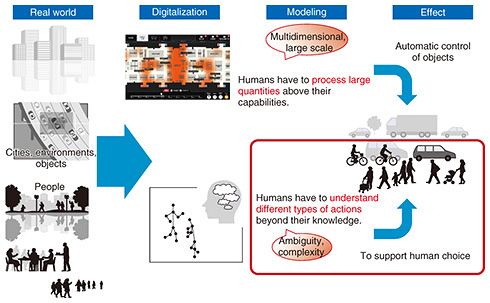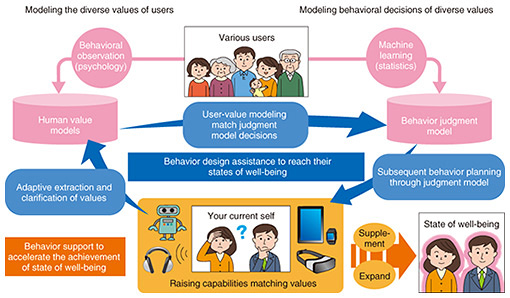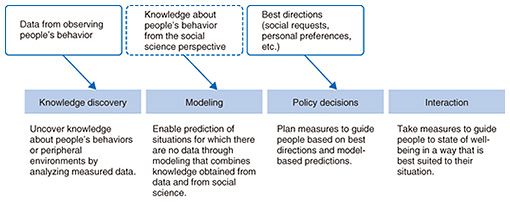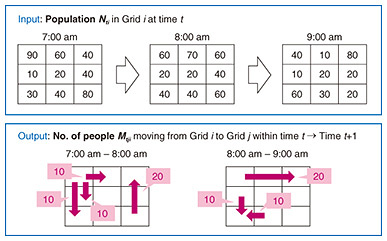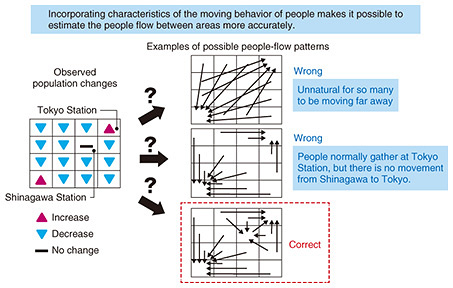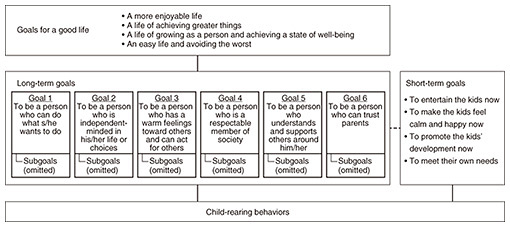 |
|||||||
|
|
|||||||
|
Feature Articles: ICT R&D Initiatives for a Smart World that Harmonizes People and Environments Vol. 18, No. 3, pp. 52–58, Mar. 2020. https://doi.org/10.53829/ntr202003fa8 User Experience Method for Deeper Understanding People’s Values to Design and Change Their BehaviorAbstractAdvances in technology has expanded the scope of people’s lives even though the behavior of people living comfortable lives has become complicated along with various personal values systems. This article introduces methods with which people can naturally achieve a state of well-being faster by enabling them to adopt technology to change their behavior for the better. There are two methods, one for analyzing people’s daily behaviors or Internet usage for understanding people and the other for providing technology to promote awareness and a sense of achievement by clarifying mechanisms of change regarding people’s minds and behaviors. Keywords: behavior design, understanding human behavior, well-being 1. Behavior design to achieve a state of well-beingThe recent spread of the Internet of things (IoT), in which all things are connected through the Internet, has brought closer a world in which it is possible to determine what is happening now, what will happen in the future, and how objects, e.g., devices, should move towards obtaining desirable results, based on multi-dimensional, large-scale data obtained from IoT that far exceeds the processing capabilities of humans. If ambiguous and complicated human behaviors can be understood using artificial intelligence (AI), it will likely become possible to plan not only how objects but also people should move. AI can study what is positive behavior from their behaviors to provide feedback for them to change their behavior for the better. If this cycle can be sustained, people can achieve a state of well-being [1] (Fig. 1).
Therefore, with findings from our previous studies on (for example) service-design-process research and analysis and modeling of spatio-temporal behaviors, we aim to develop interaction technology that will influence human cognition to enable people to achieve a state of well-being so they can continue in a more positive direction. This technology will be achieved by scaling various ambiguous and diverse values such as prioritizing objects—not only economic values, understanding ideals that people pursue, observing what behaviors people engage in to reach their ideals and modeling them, and enabling the prediction and measurement of success levels from those models. If data from various people can be acquired through IoT devices, through those observed data and interviews regarding people’s ideals and daily activities, the values they have, and how those levels are expressed can be handled in models of user values. It will also be possible to deepen understanding of the behavioral models that explain why a person takes a certain action and what principle led to that action from the actual behavioral data. Once modeled, the current situation can be fit to the model, what will happen from the fitted model can be predicted, and how results will change with what actions can be understood so that results of action towards an ideal can be predicted. Then, by understanding how people accept information and feel about conversation and communication with other people, etc. and by providing a means to give them awareness, behaviors can be designed that will lead people to predicted results that approach overall and individual ideals so that environments to assist people in reaching a state of well-being can be created (Fig. 2).
These environments could work in concert daily to encourage behaviors under various conditions where there is a need for individual or group optimized behavior, such as finding the shortest time when moving, avoiding congestion, or wanting to visit various places. This could lead to a less crowded society as a whole. Also, through dialogue between people and staff at helpdesks, shops, or neighbors, this could lead people in a direction that satisfies not only the individual but also stakeholders. To induce positive behaviors without one’s (people’s) awareness, similar to if one was moving by one’s own will, we aim to support people’s natural behavior to smoothly and comfortably improve themselves by providing necessary information if they become confused and supporting those with diminished physical capabilities. When conducting daily activities will be possible in both the real and virtual worlds, it might be possible to have personalities in both. Even if a person uses different personalities in both, has several living spaces including virtual space, and their values become more diversified, we will be able to promote research and development for assisting people towards positive behavior more naturally. We hope this interaction technology will improve people’s lives. 2. Technology to achieve behavioral design2.1 Understanding human behaviors for achieving a state of well-beingTo lead a person to a state of well-being, it is important to understand the behaviors (e.g. moving from A to B, staying at A, eating, etc.) and states (e.g. physical and mental conditions, etc.) of that person and the surrounding environment. As mentioned above, data collection has been rapidly progressing due to the wide spread of IoT. Thus, we are pursuing research and development based on the framework shown in Fig. 3, aiming at a world that uses data to bring people into a state of well-being. The most important point is not only to understand the behavior recorded in observation data but also construct a behavior model based on those data. Since this understanding and modeling make it possible to understand the behavior of people in situations in which there are no observational data and predict future behaviors, we believe it will be easier to decide on strategies to change the future for the better.
To achieve this, people flow estimation (PFE) [2] makes it possible to understand the people flow not explicitly included in data by using the characteristics of human behavior obtained from data analysis as knowledge. As shown in Fig. 4, from population information of each area at each time step, PFE estimates the people flow between cells over time. The point with this method is that it estimates the people flow between areas from only the population information of each area at each time step, which does not explicitly represent crowd movement. When the number of areas where people are moving is N, this method solves the problem of estimating people flow between areas (number of unknown values (transition in population between each area pair) is N2) from population information for two time steps (number of known values (population of each area) is N × 2). If this problem is considered, there will be too many solutions that are consistent with the observed population data. Since there will be multiple movement patterns that can explain the change in population for each observed area of the input data, it will be difficult to accurately estimate the correct people flow.
In response to this problem, we first clarified the characteristics of human behavior in cities by analyzing real data. We then introduced the characteristics of human behavior obtained from data analysis as a constraint to the problem of estimating people flow between areas to narrow down the solutions. Specifically, we used the following findings, which were obtained based on people-moving data in cities.
Based on the above findings, instead of directly estimating the population between areas (number of unknown values is about N2), we estimate scores that reflect the characteristics of each area (e.g. score of how easily people gather in each area, score of how likely people depart from each area; number of unknown values is about N × 2) that affect the movement of people (Fig. 5). PFE uses the following formula to understand the flow of people. (Ease of moving from area i to area j) ≈ (probability of departure from i) × (ease of people gathering at j) × (ease of movement based on the distance between i and j).
This model makes it possible to select a solution that seems to move people. It is also possible to drastically reduce the unknown values that need to be calculated, resulting in much lighter computation cost. The above is an example of incorporating the knowledge obtained from data analysis into a model to more accurately estimate human behavior without explicit observed data of the behavior. In addition to the knowledge gained from data analysis, we will also try to model human behavior using social science knowledge. We believe that this modeling will enable us to understand various human behaviors to effectively change them for the better. 2.2 Research of understanding human values and interaction for achieving a state of well-beingClarifying the mechanism of well-being is obviously not something that can be done overnight. A state of well-being is very different for each person and changes depending on the surrounding environment and circumstances. Moreover, it is well known that people’s thoughts and judgments are often irrational. To achieve our goal of clarifying the mechanism of well-being, we are conducting research to both deeply understand the diverse values of people and develop support methods (interaction technology) by using knowledge from a wide range of fields such as psychology, engineering, and design (research to understand values). To understand people’s values related to well-being, our approach is to clearly define targets and study people’s values both quantitatively and qualitatively. For example, when we previously focused on parents who are raising small children, we conducted both web surveys and interviews to understand their values and child-rearing behaviors [3]. The results indicated that parents have both short-term and long-term goals. There are six long-term goals regarding their children’s futures. Figure 6 illustrates the general results. Some parents wanted to entertain or calm their children (“To make the kids feel calm and happy” in the diagram). These factors can be explained as short-term goals. The same parents may also whish their children “To be a person who can do what s/he wants (goal 1)” or “to be a person who is independent-minded in his/her life or choices (goal 2)”, which can be explained as long-term goals. Having both long and short-term goals, items that are given priority differ depending on the state of the parent’s mind, environments, and the state of the child, which may lead to disparate child-rearing behavior.
As shown in Fig. 6, parents’ long-term goals for their children’s future can be categorized into six types with the degree of emphasis depending on the parent. There are also multiple types of “good life goals” positioned above the long-term goals. The various factors make it difficult to understand the reason of behavior. However, our approach of using both qualitative methods, such as interviews, and quantitative methods, such as large-scale questionnaires, enable us to deeply understand human values. In the case of understanding parents, after modeling values, we developed scales to enable easy measurement of value types, which would lead to developing support services that match parents’ values. The reason we focus on interaction research is because people are social creatures, and interactions with others have a significant impact on the state of well-being. Therefore, we are focusing on the effects of interactions among diverse people and developing methods for achieving a state of well-being. Since it is important to understand the interactions among people and what changes the motives and thoughts of people, we are conducting research in the real world on limited targets and situations to observe them as naturally as possible. We are mostly designing and developing tools/programs to support dialogue in living labs. Living labs is an approach that involve users as co-creators in the service-design process. It is attracting attention not only for service design but also as a methodology useful for community development including local revitalization. It also contributes to a state of well-being. Incorporating living lab activities in the community enables people to live with better awareness. Hence, we are implementing living labs in multiple locations, such as in the Japanese cities of Omuta, Sendai, and Yokohama, while engaging in dialogue with partners with differing values such as residents, companies, local governments, and universities. For example, at Tama-Plaza in Yokohama, we are studying how to support and accelerate the efforts of the local residents, companies, and government by developing frameworks and tools to communicate with one another to solve various problems the town has. We are also conducting research in Omuta, a city that places importance on a person-centered view of people that integrates the idea of “living true to oneself” while remaining connected with surrounding people, in collaboration with the local government, organizations, and companies to understand what is required to improve the town so that people can live in it with this view. Through this field research, we are painstakingly clarifying important viewpoints and developing frameworks and tools to support people in interacting with one another to achieve states of well-being. 3. Future developmentsPeople’s values and behaviors are diverse and sometimes irrational. Understanding, modeling, and transforming them into a better state is certainly a very difficult challenge. We will continue to engage in research and development with the aim of improving the well-being of people and solving social issues by using knowledge from a wide range of fields such as psychology, data analysis, and design. References
|
|||||||

